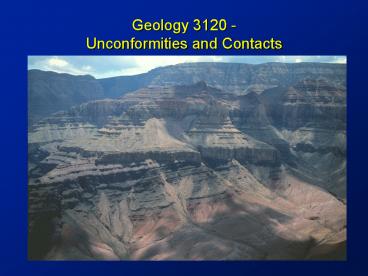Geology 3120 Unconformities and Contacts
1 / 17
Title:
Geology 3120 Unconformities and Contacts
Description:
Siccar Point, Berwickshire, Scotland. James Hutton (1788) ... Principle of Original Horizontality - sediments are deposited in horizontal layers ... –
Number of Views:869
Avg rating:3.0/5.0
Title: Geology 3120 Unconformities and Contacts
1
Geology 3120 - Unconformities and Contacts
2
Outline
- The contact that started it all
- Steno, Hutton, and Lyell
- Conformities and Unconformities
- The Grand Canyon and Contact Corner
- Intrusive contacts
- Fault contacts
- Shear zone contacts
- Exercise - timing of geologic events
3
The Contact
- Siccar Point, Berwickshire, Scotland
- James Hutton (1788)
- Vertical Silurian rocks overlain by Devonian Old
Red Sandstone
4
Stenos Principles
- Nicolaus Steno (1669)
- Principle of Original Horizontality - sediments
are deposited in horizontal layers - Principle of Superposition - the highest
material in a vertical section is the youngest - Principle of Original Continuity - sediments are
deposited in laterally continuous layers - Also consider cross-cutting relationships - if
Rock A crosscuts Rock B, then Rock A is younger
than Rock B
A
B
5
Hutton and Lyell
- Charles Lyell (1830)
- Principle of Uniformitarianism - the present is
the key to the past, or that present processes
can be used to infer past processes - Based on observations by James Hutton (1785)
- Rates of geological processes are not
necessarily constant - Catastrophic processes may occur
6
Conformable contacts and Unconformities
Conformity
Nonconformity
Angular Unconformity
Disconformity
7
The Grand Canyon
- Paleozoic sedimentary rocks (248-540 Ma)
- Angular unconformity
- Proterozoic sedimentary rocks (800-1250 Ma)
- Nonconformity
- Vishnu Group (1400-1500 Ma)
8
The Grand Canyon Unconformities
9
Contact Corner (disconformity)
Boulder Creek Granodiorite (1700 Ma)
Silver Plume Dikes (1400 Ma)
Fountain Formation (320-300 Ma)
10
Intrusive Contacts
Igneous - plutons, dikes
11
Intrusive Contacts
Sedimentary - salt structures diapirs
12
Fault Contacts
- Hurricane normal fault, Utah and Arizona
(western boundary of Colorado Plateau) - Slickenline lineations (probably quartz growth)
- see cross-section of growth below
1.
2.
QTZ
3.
13
Shear Zone Contacts
14
Exercise - timing of geologic events
The following exercise is designed to introduce
you to how sediments and intrusive rocks can be
used to constrain the timing of deposition,
faulting, folding or other deformational
processes. The figure is a block diagram of a
sequence of rocks that have undergone a period of
folding, thrust faulting, normal faulting and
intermittent magmatic events (dike intrusion).
See if you can determine the geologic history
of deposition, intrusion, and deformation by
examining the contact relationships between the
sediments, igneous rocks, and faults.
15
Block model for exercise
16
Geologic History
- 12 Ma dike
- 15 Ma dike
- Normal fault
- 20 Ma sed
- 22 Ma sed
- Erosion
- Thrust fault
- Folding
- Layer B
- 60 Ma sed
- Layer G
- 70 Ma sed
- 80 Ma sed
17
References
Slide 6 Busch, R. M. and D. Tasa, Laboratory
Manual in Physical Geology, 3rd. Ed., American
Geological Institute and National Association of
Geology Teachers, 260 p., 1990. Slide 11 Twiss,
R. J. and E. M. Moores, Structural Geology, W. H.
Freeman Co., New York, 532 p., 1992.































